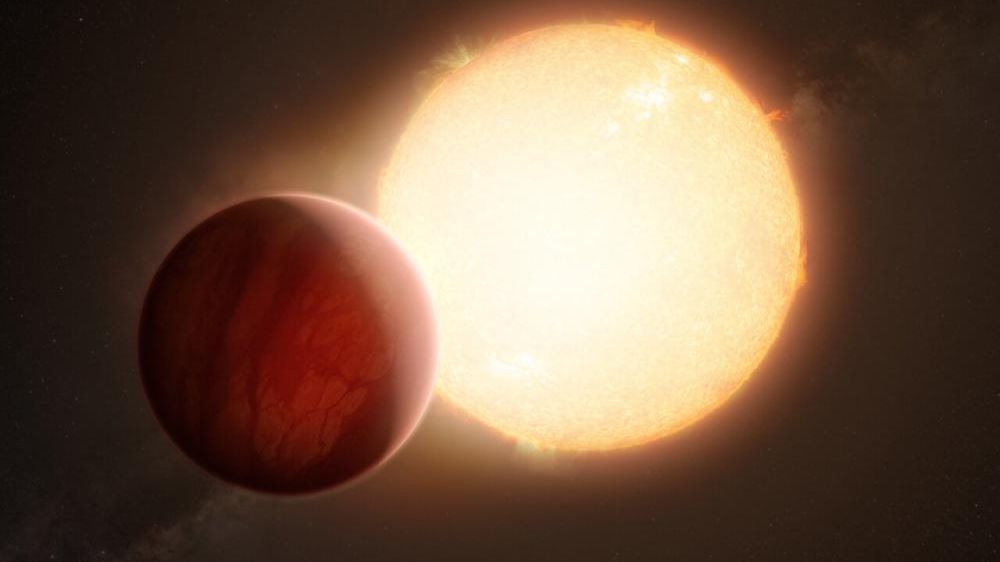published
AstrophysicsA great discovery in the atmosphere of two planets
The ESPRESSO spectrometer detected barium around two exoplanets, at an altitude where this heavy element should not be found.
This artist’s impression shows an extremely hot exoplanet about to transit in front of its host star. When starlight passes through the planet’s atmosphere, it is filtered by chemical elements and molecules in the gaseous layer. Using sensitive instruments, signatures of these elements and molecules can be observed from the Earth.
ESO/m. Cornmeiser
An international team consisting of scientists from the University of Geneva (UNIGE) and the National Research Center (PRN) PlanetS has discovered the heaviest element ever found in the atmosphere of an exoplanet: barium. The feat was made possible by ESPRESSO, a spectrometer largely developed by UNIGE and installed on the European Southern Observatory’s Very Large Telescope (ESO’s VLT).
Scientists were surprised to discover such an element at high altitudes in the atmosphere of the super-hot gas giants WASP-76 b and WASP-121 b, because their strong gravity (theoretically) is already pushing it toward their deep layers. This study will be published in the journal “Astronomy and Astrophysics”raises questions about the nature of this strange atmosphere.
know Geneva
“This discovery demonstrates once again the effectiveness of Geneva knowledge in the field of high-resolution spectroscopy,” comments Francesco Pepe, full professor in the Department of Astronomy at UNIGE, co-author of this research and lead initiator of the ESPRESSO instrument. “This tool allows us to accurately detect new exoplanets using the radial velocity method, but also to characterize the composition of the atmospheres of exoplanets, this study explains.”
WASP-76 b and WASP-121 b are not ordinary exoplanets. Both are known as superhot Jupiters because they are about the same size as Jupiter, but their surface temperatures are extremely high, exceeding 1,000 degrees Celsius. This explains the proximity of these planets to their host star. Their orbit around it only lasts a day or two, which gives them rather strange properties: in WASP-76 b, for example, astronomers think it’s raining iron.
Accidental discovery
Tomas Azevedo Silva, a doctoral student at the University of Porto and the Astronomical Institute of Portugal, who led the study, says the discovery of barium is “a kind of ‘accidental’ discovery.” We weren’t expecting or looking for barium in particular and had to verify that it was from the planet, The presence of this metal on an exoplanet has not been previously recognized.”
Therefore, scientists were surprised to find barium, which is 2.5 times heavier than iron, in the upper layers of the atmospheres of both planets. “So there must be a physical mechanism that we don’t know that is bringing the barium into the upper layers of hot Jupiter’s atmosphere,” explains David Ehrenreich, associate professor in the UNIGE Department of Astronomy and co-author of the study. .
Very strange worlds
The fact that barium has been detected in the atmosphere of these planets suggests that this class of planets may be even more exotic than previously thought. The question for scientists now is to determine the natural process that could cause the presence of this heavy element at high altitudes on these exoplanets. Using future instruments, such as the ArmazoNes High Dispersive Spectrometer (ANDES), which will operate on ESO’s upcoming Very Large Telescope (ELT), astronomers at UNIGE, PlanetS and around the world will be able to study the atmospheres of exoplanets large and small. These tools will also make it possible to analyze rocky Earth-like planets in a more comprehensive way and gather more indications about the nature of these alien worlds.

“Hardcore beer fanatic. Falls down a lot. Professional coffee fan. Music ninja.”



![[VIDÉO] LPHF: Like Cole Caufield, Ann-Renée Desbiens has her own unique shoes](https://m1.quebecormedia.com/emp/emp/63411_07894593662cf2-8a9e-4bd6-aa34-c999d634a876_ORIGINAL.jpg?impolicy=crop-resize&x=0&y=291&w=3492&h=1966&width=1200)



More Stories
First Date Date: 7 Tips
Martin Freeman stopped being a vegetarian after 38 years
MS-DOS 4.0 source code release: What a story!